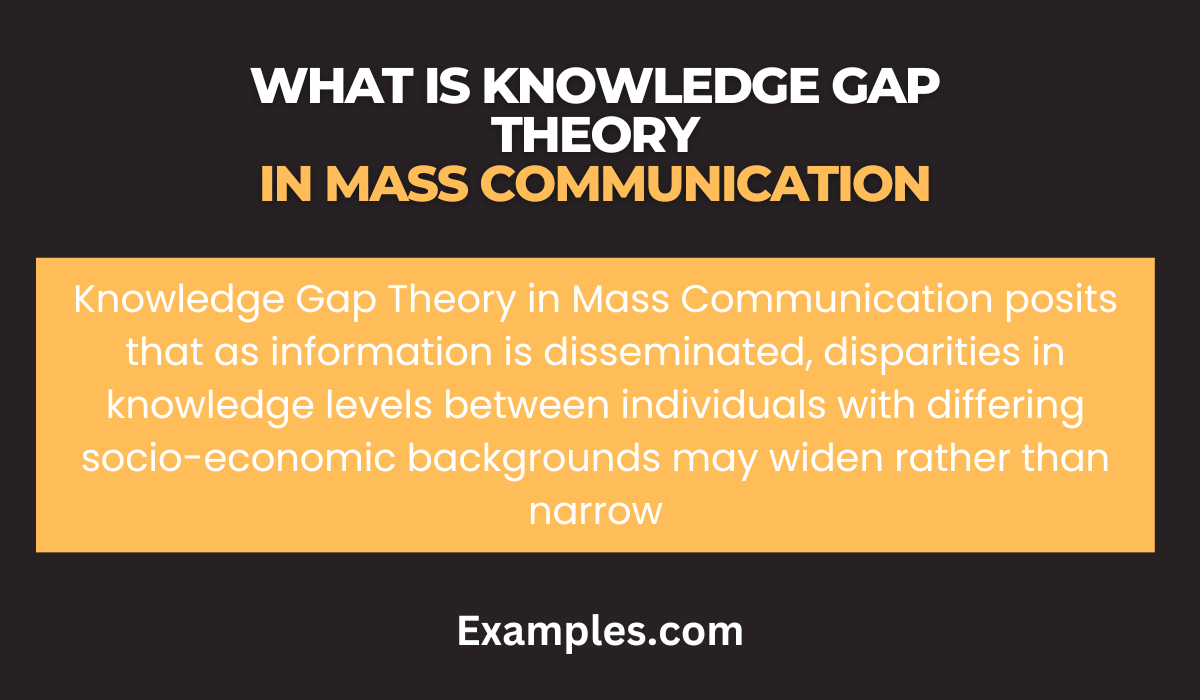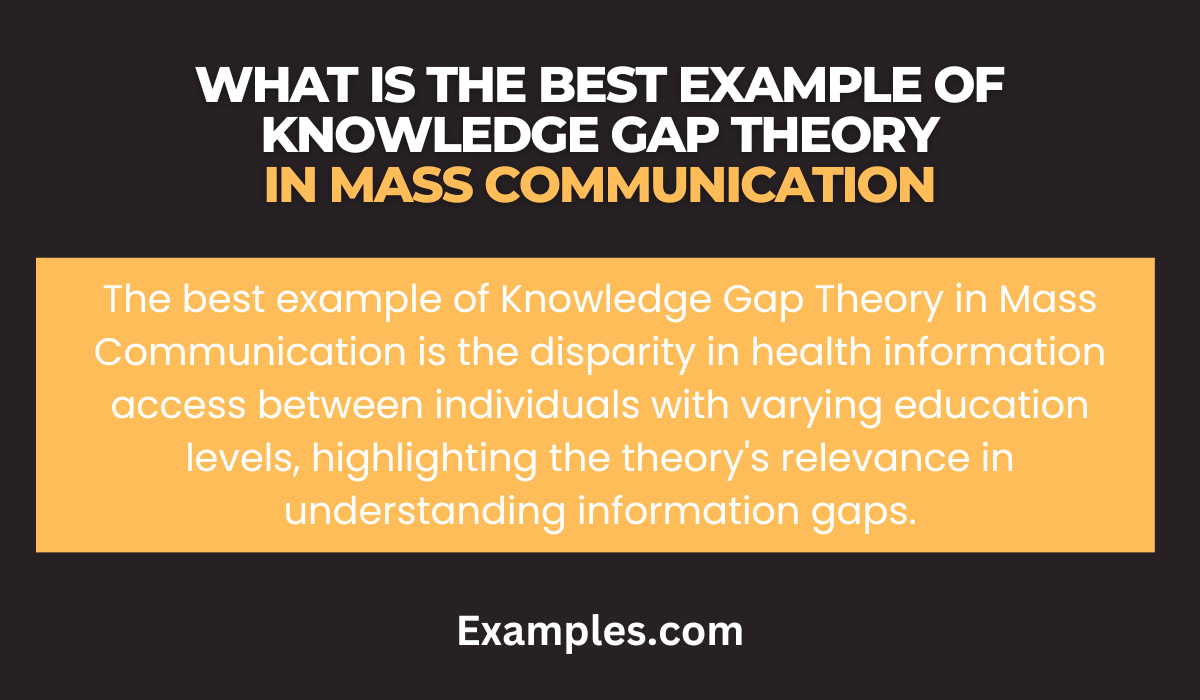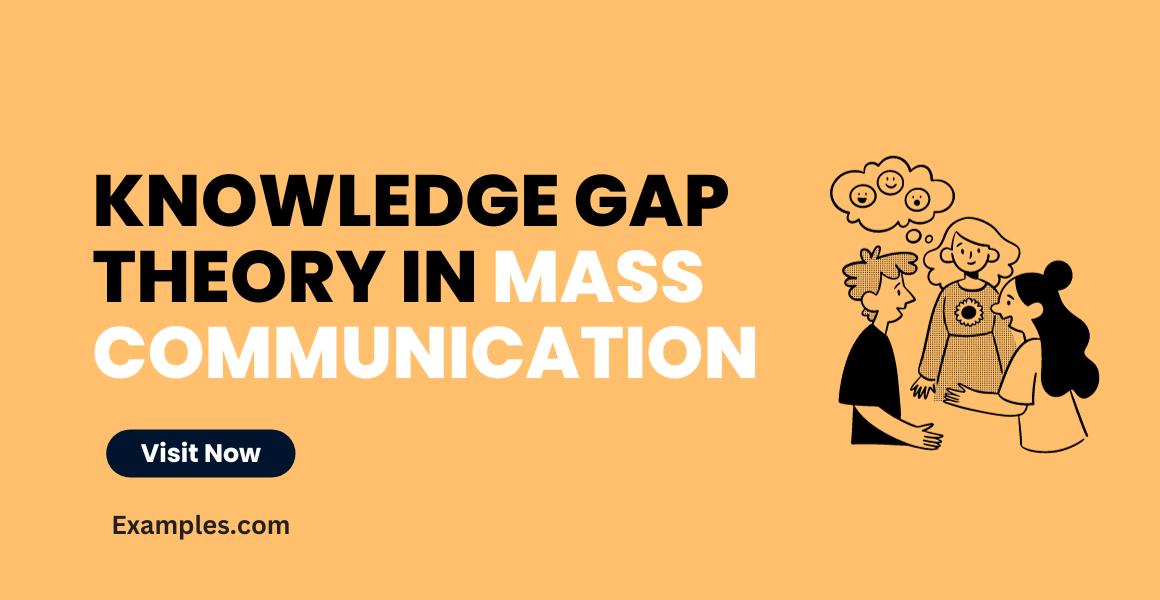29+ Knowledge Gap Theory in Mass Communication Examples
Understanding the Knowledge Gap Theory in Mass Communication is crucial in today’s information-rich world. This theory highlights the widening gap in knowledge between those with more access to information and those with less. It’s a concept that has profound implications in various fields, including Journalism Mass Communication and Social media Mass Communication. As mass communication becomes more pervasive, understanding its impact on society and individual knowledge becomes essential. This guide delves into the intricacies of the Knowledge Gap Theory, illustrating its significance in contemporary mass communication scenarios.
What is Knowledge Gap Theory in Mass Communication
The Knowledge Gap Theory in mass communication is a concept that explains the disparities in the acquisition of knowledge among various segments of a population based on socioeconomic status. This theory proposes that individuals with higher socioeconomic status tend to have more access to information and can process this information more effectively compared to those with lower status. As a result, gaps in knowledge and understanding between different groups in society widen over time, especially as new information and technology emerge.

History of Knowledge Gap Theory in Mass Communication
The concept of the Knowledge Gap Theory was first introduced in the 1970s by Tichenor, Donohue, and Olien. They posited that the increase in information in society does not uniformly permeate all social strata. Instead, segments of the population with higher socioeconomic status are more likely to benefit from this information influx, thereby widening the gap. This theory highlighted the role of mass communication in potentially exacerbating social inequalities due to differential access to information.
What is the Best Example of Knowledge Gap Theory in Mass Communication
A quintessential example of the Knowledge Gap Theory can be seen in the context of health communication. People from higher socioeconomic backgrounds often have better access to health-related information through various mass communication channels such as specialized health websites, medical journals, and educational seminars. In contrast, individuals from lower socioeconomic groups might rely on more general and less specialized sources, like public relations mass communication or broadcasting mass communication. This difference in access and quality of information leads to a disparity in health knowledge and, consequently, health outcomes between these groups.
In summary, the Knowledge Gap Theory in mass communication underscores the influence of socioeconomic status on information accessibility and comprehension. This theory is critical in understanding how information dissemination can inadvertently deepen societal divides, particularly in areas such as health, education, and political awareness.

30 Examples of Knowledge Gap Theory in Mass Communication

- Social Media’s Role: Social media platforms have become a cornerstone in disseminating information. However, not everyone has the same level of access or digital literacy. For instance, younger generations may receive news primarily through social media, creating a knowledge gap with older generations who might rely on traditional media.
- Broadcasting and Accessibility: Broadcasting Mass Communication, through television or radio, has long been a primary information source. However, regions with limited access to broadcasting technology or areas where broadcasting is heavily controlled by the state can experience significant knowledge gaps.
- Educational Programs: In educational settings, Mass Communication Examples in School highlight the gap. Schools with better resources can provide students with more exposure to various mass communication forms, unlike under-resourced schools.
- Public Health Campaigns: During public health crises, the dissemination of vital information via mass communication channels can create gaps. Those with limited access to these channels may not receive timely or accurate health information.
- Political Campaigns: In political campaigns, candidates often use targeted mass communication strategies. This can lead to a knowledge gap among voters who only receive information from certain media channels, influencing their political awareness and decision-making.
- Economic Disparities: Economic status can influence access to mass communication, leading to a knowledge gap. Wealthier individuals may have more access to digital platforms, while those in lower economic brackets might rely on traditional media.
- Global News Coverage: The coverage of global events varies significantly across different mass communication mediums. This variation can lead to a knowledge gap in understanding global issues, depending on the source of information.
- Digital Literacy: The varying levels of digital literacy across different demographics create a gap in understanding and interpreting information received through digital channels of mass communication.
- Cultural Perspectives: Cultural differences in interpreting mass communication messages can lead to a knowledge gap, as messages are often designed with a particular audience in mind.
- Accessibility for the Disabled: The lack of mass communication tailored to the needs of disabled individuals can lead to a significant knowledge gap in this demographic.
- Internet Penetration: Areas with low internet penetration experience a knowledge gap, as they lack access to Mass Communication in a Digital Age, which includes online news, blogs, and social media updates.
- Language Barriers: Non-native speakers may face challenges in comprehending mass communication content, creating a knowledge gap in multilingual societies.
- Rural vs. Urban Divide: Rural areas might have limited access to Television Mass Communication and high-speed internet, resulting in a knowledge gap compared to urban regions.
- Age Differences: Older adults may not engage with newer forms of mass communication such as Blog Mass Communication or social media, leading to a gap in knowledge compared to younger, more digitally-savvy populations.
- Educational Background: Individuals with higher education levels can better understand and interpret complex information disseminated through mass communication, while those with less education may not, leading to a knowledge gap.
- Economic News Understanding: The complexity of economic news via channels like Television Mass Communication can widen the knowledge gap between financially literate and illiterate audiences.
- Health Misinformation: During health crises, misinformation spread through various mass communication channels can exacerbate the knowledge gap, particularly affecting those who lack critical health literacy.
- Political Polarization: Selective exposure to like-minded political content, especially in Social media Mass Communication, can create echo chambers, widening the knowledge gap between different political groups.
- Cultural Content: Mass communication that predominantly features Western culture can lead to a knowledge gap in understanding diverse global cultures.
- Access to Scientific Research: Scientific research and discussions often disseminated through specialized channels of mass communication can create a knowledge gap among the general public.
- Gender-Specific Communication: Certain mass communication messages are targeted at specific genders, potentially creating a knowledge gap between different gender groups.
- Accessibility in Emergencies: In emergency situations, the reliance on mass communication for information can lead to a knowledge gap for those in areas with disrupted communication channels.
- Satellite Television Access: Regions without access to satellite television, a key form of Broadcasting Mass Communication, can miss out on global news and entertainment, creating a knowledge gap.
- Email Communication in Businesses: In the corporate world, a reliance on Email Mass Communication can disadvantage those not proficient in email etiquette and technology.
- Billboard Advertising Impact: Billboard Mass Communication can influence public opinion and awareness in urban areas, creating a knowledge gap with those in areas where such advertising is scarce.
- Impact of Public Relations: Public Relations Mass Communication strategies can shape public opinion and awareness on various issues, leading to a knowledge gap among those not exposed to these campaigns.
- Historical Documentaries: The broadcasting of historical documentaries can create a knowledge gap between viewers who have access to these programs and those who do not.
- Film and Cultural Representation: The portrayal of different cultures and societies in films can lead to a knowledge gap in understanding these cultures among audiences.
- News Media Literacy: The ability to critically evaluate news media, a crucial aspect of Journalism Mass Communication, varies among individuals, leading to a knowledge gap.
- Technological Advancements: Rapid advancements in technology, especially in Digital Mass Communication, can create a knowledge gap among those unable to keep pace with these changes.
Role of Knowledge Gap Theory in Mass Communication
The Knowledge Gap Theory plays a pivotal role in the field of Mass Communication. This theory posits that information in a society is not distributed equally, and as new information is introduced, this gap tends to widen. This theory is especially relevant in today’s digital age where access to information is varied among different socio-economic groups. Here are key points highlighting the role of Knowledge Gap Theory in Mass Communication:
- Identifying Information Disparities: This theory helps in identifying the gaps between different societal segments in terms of access to information.
- Guiding Content Creation: It influences content creators to tailor their messages to bridge these knowledge gaps, making information more accessible.
- Shaping Public Policy: The theory aids policymakers in understanding the disparity and implementing policies to reduce the information gap.
- Influencing Media Strategies: Media outlets utilize this theory to devise strategies that cater to diverse audiences with varying levels of information access.
- Enhancing Audience Engagement: By addressing the knowledge gap, mass communication can become more inclusive, thus engaging a broader audience.
Importance of Knowledge Gap Theory in Mass Communication
The importance of the Knowledge Gap Theory in the realm of Mass Communication is multifaceted:
- Promotes Inclusivity in Information Dissemination: The theory emphasizes the need for inclusive communication, ensuring all demographic segments receive vital information.
- Improves Communication Effectiveness: Understanding this theory enables communicators to craft messages that are more effectively understood by a wider audience.
- Reduces Socio-economic Disparities: It plays a crucial role in reducing socio-economic disparities in information access.
- Fosters Democratic Participation: By bridging the information gap, it encourages more informed participation in democratic processes.
- Guides Educational Initiatives: The theory is instrumental in shaping educational programs aimed at increasing media literacy and information accessibility.
How to Use Knowledge Gap Theory in Mass Communication
Implementing the Knowledge Gap Theory in Mass Communication involves strategic planning and understanding of the audience:
- Conduct Audience Research: Understand the information needs and access levels of different audience segments.
- Tailor Messages Appropriately: Create content that addresses the specific information gaps identified in the audience research.
- Utilize Varied Communication Channels: Employ a mix of traditional and digital media to reach a broader audience.
- Engage in Community Outreach: Directly engage with communities to understand and address their specific information needs.
- Monitor and Adapt Strategies: Continuously assess the effectiveness of communication strategies in bridging the knowledge gap and make necessary adjustments.
The Knowledge Gap Theory in Mass Communication underscores the importance of addressing information disparities among different social groups. By tailoring content and strategies to bridge these gaps, communicators can foster a more informed, inclusive society, enhancing democratic participation and reducing socio-economic disparities in information access.



